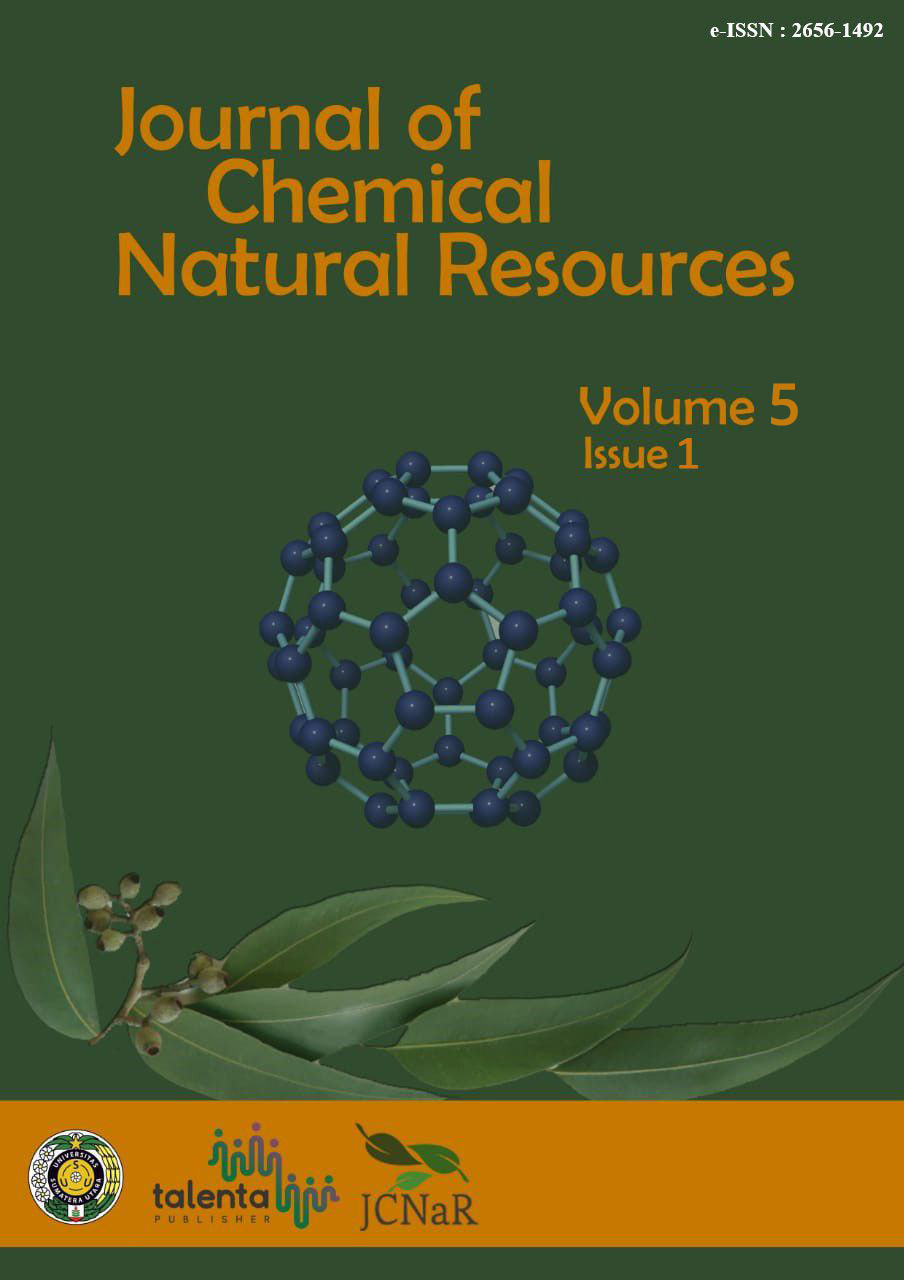Analysis of Fatty Acid Composition Using GC-MS and Antibacterial Activity Test of n-Hexane Extract from Jengkol Seeds (Pithecellobium lobatum Benth.)
DOI:
https://doi.org/10.32734/jcnar.v5i1.11991Keywords:
Agar Diffusion, Antibacterial, GC-MS, Jengkol Seeds.Abstract
Analysis of fatty acid composition using GC-MS and antibacterial activity test of n-hexane extract from Jengkol seeds (Pithecellobium lobatum Benth) was performed with the maceration method to obtain n-hexane extract of Jengkol seeds. The n-hexane extract of Jengkol seeds was first esterified using methanol (1.7 ml): 98% H2SO4 (0.3 ml): Chloroform (2 ml), then analyzed its fatty acid composition by GC-MS method. The results of fatty acid composition analysis found in Jengkol seeds are saturated fatty acids, namely: Margaric Acid (1.10%), Palmitate Acid (2.64%), stearic acid (12.01%), and unsaturated fatty acids, namely: Linolelaidate acid (10.02%) %), and oleic acid (74.23%). The antibacterial activity test against Escherichia coli and Staphylococcus aureus using n-hexane extract of Jengkol seed was done by agar diffusion method. The concentration variations were 50 mg/ml, 150 mg/ml, and 250 mg/ml. From the results of this test, n-hexane Jengkol seeds have an antibacterial activity that can inhibit bacterial growth but is weak (≤14 mm).
Downloads
References
Pitojo, S. 1992. Cultivation and Benefits Jengkol. Yogyakarta.
Alatas, F. 2017. The Effect of Giving Extracts Ethanol 96% Jengkol (Pithecollobiumlobatum) on histopathological features of kidney tissue and increased levels of urea creatinine in white male rats (Rattus norvegicus) Sprague Dawley Strain. Bandar Lampung: Lampung University.
Roswaty, A. 2010. All About Jengkol & Petai. Jakarta: PT Gramedia Pustaka.
Ketaren S, 1986. Food Oil and Fat. Jakarta: UI-Press.
Fardiaz S. 1987. Antimicrobial compounds. Bogor: PAU.
Huda, S. 1997. Study on Dental Plaque Activity Of Mace And Betel Nut And Their Active Components Japan. Ph.D. Thesis
Rahmawati. 2010. Simplicia Characterization and Antibacterial Activity Test of Extracts Jengkol Fruit Skin (Pithecellobium lobatum Benth.) Against Escherichia coli, Shigella dysenteriae, and Salmonella Typhimurium bacteria. University North Sumatera.
Yusra, RF 2012. Extract Inhibitory Test Jengkol Fruit Peel Ethanol (Pithecellobium lobatum Benth ) on Bacterial Growth Methichilin-resistant Staphylococcus aureus. Aceh: Faculty of Medicine Unsiyah
Silverstein RM, Bassler GC, Morrill TC, 1984. Spectrometric Investigations of Organic Compounds. Fourth Edition. Translated by AJ Hartomo, et al and Anny Victor Purba. Jakarta: Erlangga.
Clinical and Laboratory Standard Institute. 2012. Performance Standard for Antimicrobial Disk Susceptibility Test: Approved Standards - Eleventh Edition.
Philip. LC 1967. Microbiology. London: WB Saunder Company
Pratiwi, ST. 2008. Pharmaceutical Microbiology. Jakarta: Erlangga
Chamberlain NR., Mehrtens BG., Xiong Z., Kapral FA., Boardman JL., Rearick JI. (1991) Correlation of carotenoid production, decreased membrane fluidity, and resistance to oleic acid killing in Staphylococcus aureus18Z. Infect Immun. Volume 59.
Pelczar, MJ, Chan ECS. 1986. Basics Microbiology, Volume 1. Jakarta: UI Press

Published
How to Cite
Issue
Section
Copyright (c) 2023 Journal of Chemical Natural Resources

This work is licensed under a Creative Commons Attribution-ShareAlike 4.0 International License.







